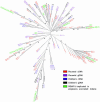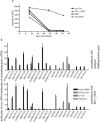Transcribed var genes associated with placental malaria in Malawian women
- PMID: 16861676
- PMCID: PMC1539630
- DOI: 10.1128/IAI.01978-05
Transcribed var genes associated with placental malaria in Malawian women
Abstract
Determining the diversity of PfEMP1 sequences expressed by Plasmodium falciparum-infected erythrocytes isolated from placentas is important for attempts to develop a pregnancy-specific malaria vaccine. The DBLgamma and var2csa DBL3x domains of PfEMP1 molecules are believed to mediate placental sequestration of infected erythrocytes, so the sequences encoding these domains were amplified from the cDNAs of placental parasites by using degenerate oligonucleotides. The levels of specific var cDNAs were then determined by quantitative reverse transcription-PCR. Homologues of var2csa DBL3x were the predominant sequences amplified from the cDNAs of most placental but not most children's parasites. There was 56% identity between all placental var2csa sequences. Many different DBLgamma domains were amplified from the cDNAs of placental and children's isolates. var2csa transcripts were the most abundant var transcripts of those tested in 11 of 12 placental isolates and 1 of 6 children's isolates. Gravidity did not affect the levels of var2csa transcripts. We concluded that placental malaria is frequently associated with transcription of var2csa but that other var genes are also expressed, and parasites expressing high levels of var2csa are not restricted to pregnant women. The diversity of var2csa sequences may be important for understanding immunity and for the development of vaccines for malaria during pregnancy.
Figures




References
-
- Beeson, J. G., E. J. Mann, S. R. Elliott, V. M. Lema, E. Tadesse, M. E. Molyneux, G. V. Brown, and S. J. Rogerson. 2004. Antibodies to variant surface antigens of Plasmodium falciparum-infected erythrocytes and adhesion inhibitory antibodies are associated with placental malaria and have overlapping and distinct targets. J. Infect. Dis. 189:540-551. - PMC - PubMed
Publication types
MeSH terms
Substances
Associated data
- Actions
- Actions
- Actions
- Actions
- Actions
- Actions
- Actions
- Actions
- Actions
- Actions
- Actions
- Actions
- Actions
- Actions
- Actions
- Actions
- Actions
- Actions
- Actions
- Actions
- Actions
- Actions
- Actions
- Actions
- Actions
- Actions
- Actions
- Actions
- Actions
- Actions
- Actions
- Actions
- Actions
- Actions
- Actions
- Actions
- Actions
- Actions
- Actions
- Actions
- Actions
- Actions
- Actions
- Actions
- Actions
- Actions
- Actions
- Actions
- Actions
- Actions
- Actions
- Actions
- Actions
- Actions
- Actions
- Actions
- Actions
- Actions
- Actions
- Actions
- Actions
- Actions
- Actions
- Actions
- Actions
- Actions
- Actions
- Actions
- Actions
- Actions
- Actions
- Actions
- Actions
- Actions
- Actions
- Actions
- Actions
- Actions
- Actions
- Actions
- Actions
- Actions
- Actions
- Actions
- Actions
- Actions
- Actions
- Actions
- Actions
- Actions
- Actions
- Actions
- Actions
- Actions
- Actions
- Actions
- Actions
- Actions
- Actions
- Actions
- Actions
- Actions
- Actions
- Actions
- Actions
- Actions
- Actions
- Actions
- Actions
- Actions
- Actions
- Actions
- Actions
- Actions
- Actions
- Actions
- Actions
- Actions
- Actions
- Actions
- Actions
- Actions
- Actions
- Actions
- Actions
- Actions
- Actions
- Actions
Grants and funding
LinkOut - more resources
Full Text Sources

